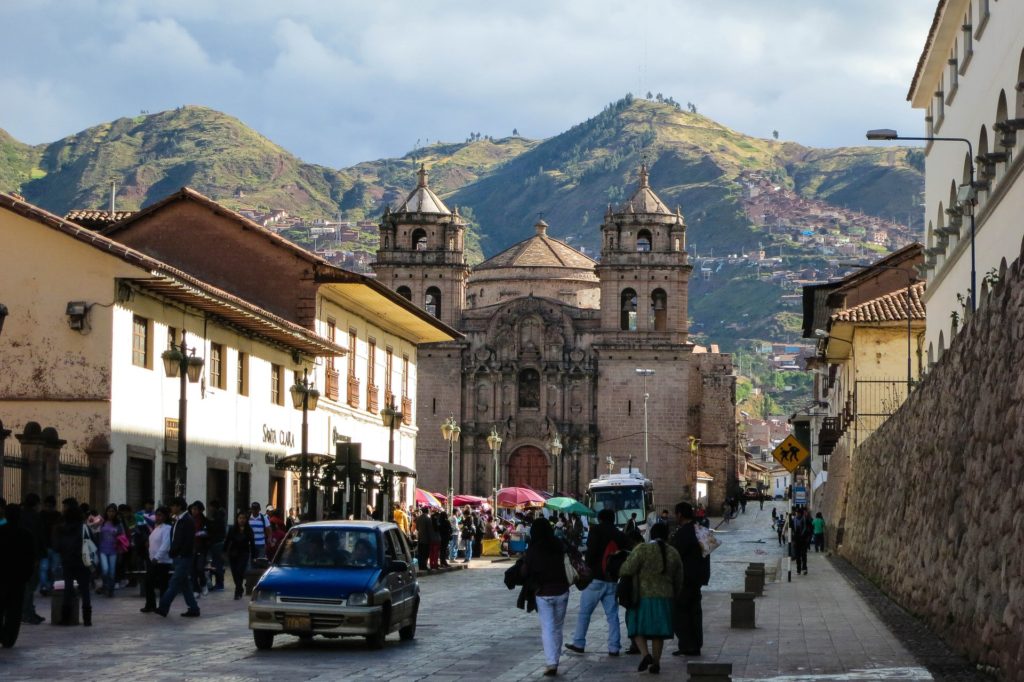Cusco: The Inca Capital IN the PERUVIAN ANDES
The Incas, the largest empire in the history of the Americas, controlled territory from the Peruvian Andes Mountains down to Santiago, Chile, and at the time of their rule, were the largest civilization in the world. Inhabitants as far back as 500 BC settled the lands in and around Cusco, but it was the Incas who defeated the Chanca, that would eventually make this the religious and administrative capital of their dominant empire.
Cusco, designed and built to resemble a puma, was chosen strategically for its fertile lands in the bowl of an ancient glacier lakebed, where three rivers converge from the surrounding mountains to create ideal land for crops to be grown and pastures to be sown. The Incas also used the abundance of water to create a system of aqueducts in order to grow their city’s size and population.
During the 14th and 15th century, the mighty emperors, believed to be direct descendants of the Inca sun god, used their powers to drain swamps, build up the city’s buildings, streets and squares, and construct fortresses. They designed their structures using an innovative 12 angle stone method to protect against earthquakes, and for this reason, we are fortunate and lucky to be able to appreciate these edifices today.

WHERE TO STAY
We stayed at two different locations while in Cusco, the first being a family owned and run guesthouse before our Machu Picchu trip, and the second was a more traditional hostel in the center of the city when we returned.
Our first accommodation, Inti Garden Cusco Boutique Hostel, had a relaxed atmosphere in an old colonial style building with an enclosed courtyard in close proximity to Plaza De Armas for around 25 USD per night. The family that operates the guesthouse are kind, generous, and provide helpful services such as planning and booking outings in and around Cusco. We booked a private room that was clean and comfortable, but did lack a private ensuite, which wasn’t a big deal because the shared bathrooms were always available and clean. Free breakfast is also included with the stay, and the best part is that they can prepare a packed breakfast for you if you’re leaving early in the morning for a day trip.
While it wasn’t a dealbreaker for us, the one downside to the guesthouse was the family’s constant presence in the main hangout area. It seemed like all hours of the day and night they would be watching TV or eating meals on the couch and dining tables, which was a huge deterrent for us, because we felt like we were disturbing them whenever we were down there. Besides that, the place is in a great location and quiet enough to get a good night’s sleep before long days of exploration.
We decided to switch it up when we returned from Machu Picchu and booked Pisko & Soul in San Blas, the bohemian neighborhood in the center of town. We booked a private double room in this old adobe building with an ensuite for approximately 27 USD per night. The room was a tad bit cold, but that’s what we came to expect in Peru, where you really have to fork out the extra bucks to enjoy the benefits of a heating unit.
If you’re looking for the best area to book a place in Cusco then I would definitely recommend San Blas. The Neighborhood has a lot of character and everything is within a short walking distance, from the Golden Temple, to Plaza De Armas, to the nightlife, but at the same time you’re also away from the major tourism centers.

WHAT TO DO IN CUSCO
Coricancha (the Golden Temple of the Sun) and the Church of Santo Domingo
Iglesia de Santo Domingo stands in place of the once most important Coricancha, the temple dedicated to Inti, the Sun God of the Inca empire. The House of the Sun was built with ashlar masonry using an intense amount of labor to construct the 12 point angle fortress.
Our tour guide informed us that the way in which the walls were formed is still a mystery today because of the enormous amount of technology that would have been required at the time. While the church makes up most of the grounds that the Coricancha once laid, you can still see embalmed bodies of the Children of the Sun at the golden table in chairs made of gold.
Entrance fees are around 4.50 USD for Coricancha and 2.50 for Iglesia de Santo Domingo.
As you’ll inevitably come to realize in South America, most of the impressive Native American peoples architectural feats were destroyed and replaced by churches built by the Spanish conquerors shortly after they arrived. While it is true that the Spanish conquistadors used force to take over the cities and lands of the indiginious people, it was smallpox and other diseases that they brought with them that wiped out up to 90% of the populations in the Americas. I know this is a sad point to make, but it’s also necessary knowledge to understand the mindsets and underlying resentment for Western culture that you might notice while traveling around Peru.
San Blas
I mentioned the neighborhood before but it’s worth going more into detail about specific places and things to do. You’ll notice here in San Blas a lot more permanent travelers, hippies, and artists that have called Cusco their indefinite home. We talked to many South American nomads that settled here because of the atmosphere or out of necessity (like people escaping the conditions of Venezuela).
You meander the small one-way cobble stoned streets up hills and down alleyways and find all sorts of cool bars, restaurants, and live music. One in particular that we revisited twice was Cholos Craft Beer Cusco, a hip little spot located in the courtyard of an old building, with indoor and outdoor seating. My go-to was the IPA Sexy Woman, but they have an assortment of different craft beer options to choose from, and great shared platter options if you’re feeling hungry.
If you’re going to be wandering around the entire district of San Blas, be prepared to walk up steep hills and narrow sidewalks, and try to avoid taxis and other encroaching vehicles. If you’re looking for a great view at the top of the hill, a great bar is the 180 Eco View bar. The name says it all, you get a 180° view over the Spanish tiled rooftops of Cusco and the surrounding mountains. A great place for Pisco Sours, beers, and small plates at a table near the window.

San Pedro Market
It’s easy to spend a lot of money in Cusco with so many great bars and restaurants in the center of town around Plaza de Armas, but if you’re looking for more authentic, local cuisine, then look no further than San Pedro Market. Here you’ll find locals and tourists alike battling it out to grab seats at the bars and food courts.
The trick is to find the busiest bars and tables, because you know you’re going to find the most flavorful and cheapest dishes at those spots. The locals know what they’re doing, so just follow their lead and ask for whatever the person next to you is having. And while the food is probably going to be amazing, I wouldn’t recommend food markets to people with allergies or food restrictions, because it’s going to be difficult to figure out exactly what ingredients go into each dish.
Luckily for us we had no dietary food restrictions or allergies, so we devoured whatever they gave us. Our stall offered some type of soup to go along with fried potatoes, rice, and what we thought was fried beef or pork. Whatever it was, it was tasty, filling, and cheap, and that’s exactly what you want out of a food market. Also checkout the fruit stands and try their exotic smoothies. I guarantee you haven’t tried some of the combinations of fruits they offer, and for that matter, heard of or seen some of the fruits that go into their smoothies.
Plaza de Armas
The central square of Cusco is bordered by beautiful surrounding buildings with arched walkways, Iglesia de Santo Domingo, Church de La Compañia de Jesus, the central fountain, trees, and restaurants serving all kinds of cuisines. Plaza de Armas is where you want to start your Cusco explorations, grab Peruvian coffee, and meet your tour guide to begin your free walking tour.
This colorful hub is a great place to grab a beer or Pisco Sour in the afternoon, and an even greater place to find upscale restaurants to devour a delicious meal for dinner on one of the balconies overlooking the plaza. We chose Hanz Craft Beer Restaurant to get a taste of the famous alpaca burger one particular evening, and were seated at a table with a window view. The burger was perfectly tender and juicy, and accompanied by a house brewed beer recommended by our server. Of course there are many other dine-in options around Plaza de Armas, but how can you go wrong with a tasty burger and a pint?

The jump-off point to countless trips
Cusco is the jump-off spot for so many outdoor activities and historic places to visit around the area, with the most famous of course being Machu Picchu. You also have the Sacred Valley, Rainbow Mountain, Incan ruins, Pisac, Lake Humantay, Ollantaytambo, and many others. We didn’t have time to visit all those amazing places, and hopefully one day we’ll return, but we did make it to the highlights and you’ll be able to read about those in the following articles…
